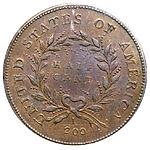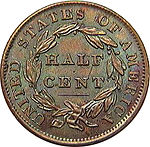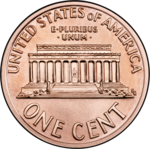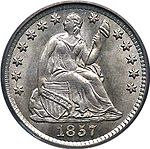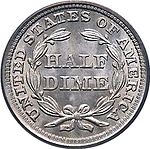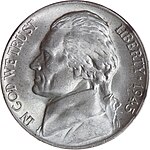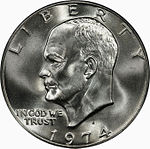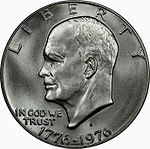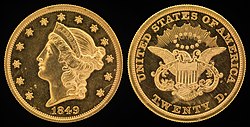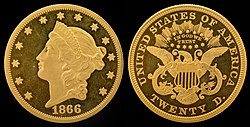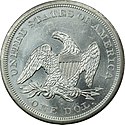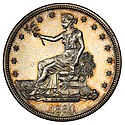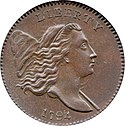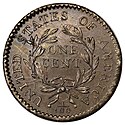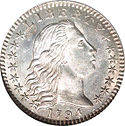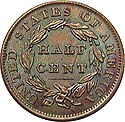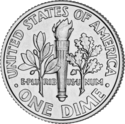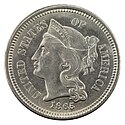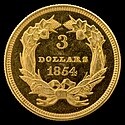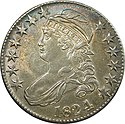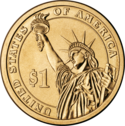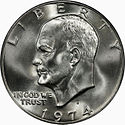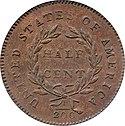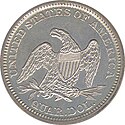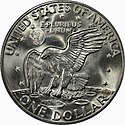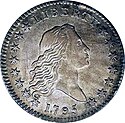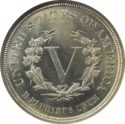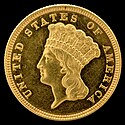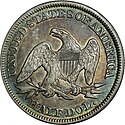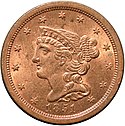Amerykańskie monety obiegowe
| Artykuł ten został zgłoszony do umieszczenia na stronie głównej w rubryce „Czy wiesz”. Pomóż nam go sprawdzić. |
Monety obiegowe Stanów Zjednoczonych Ameryki – monety obiegowe wybijane przez U.S. Mint i emitowane przez Departament Skarbu od 1792 roku, kiedy na mocy Coinage Act of 1792(ang.) ustanowiono pierwsze nominały monet oraz metale, z których miały zostać wykonane.
Nominały obiegowych monet amerykańskich to: ½ centa; 1 cent; 2 centy; 3 centy (trime); 5 centów (half dime, nickel); 10 centów (dime); 25 centów (quarter); 50 centów (half dollar); 1 dolar; 2½ dolara (Quarter Eagle); 3 dolary; 5 dolarów (Half Eagle); 10 dolarów (Eagle); 20 dolarów (Double Eagle).
Obecnie w obiegu występują następujące nominały: 1 cent, 5, 10, 50 centów, 1 dolar.
½ centa
Wprowadzenie monet półcentowych na mocy Coinage Act of 1792 było podyktowane potrzebą wydawania reszty z płatności dokonywanych przy użyciu będących wówczas w obiegu w Stanach Zjednoczonych hiszpańskich reali, których kurs ustalono na 12,5 centa[1].
Lista wszystkich monet o nominale ½ centa[2]:
1 cent
Monety o nominale jednego centa zaczęto wybijać i emitować już w 1793 roku. Ówczesne prawo stanowiło, że waga centa powinna być dwukrotnością wagi monety o nominale ½ centa. Jednocentówki zwane large cents były emitowane co roku do 1857 roku, prócz roku 1815, kiedy braki miedzi na rynku uniemożliwiły emisję tej monety[3]. W latach 50. XIX wieku koszty produkcji i dystrybucji monet miedzianych zaczęły rosnąć. Ponadto monety te cieszyły się popularnością wyłącznie w dużych ośrodkach miejskich. W 1857 roku wraz ze zniesieniem monety o nominale ½ centa wprowadzono tzw. małego centa, którego waga miała wynosić od teraz 72 grany (4,66 g), a stop miał składać się w 88% z miedzi i 12% z nikla. Nowe prawo pozwoliło także amerykańskiej mennicy i Departamentowi Skarbu wykupować stare monety centowe i półcentowe, a także monety hiszpańskie za nowe centy[4][5].
W trakcie wojny secesyjnej monety srebrne i złote zniknęły z obiegu. Również miedzioniklowe monety stanowiły rzadkość. W 1864 roku amerykański rząd ogłosił emisję centów wykonanych z brązu[6].
W 1943 roku, w związku z niedoborem miedzi na rynku spowodowanym wojną, Departament Skarbu rozpoczął emisję monet wykonanych ze stali pokrytych cynkiem. W 1944 roku powrócono do bicia monet z brązu aż do 1958 roku[7]. W latach 1959–1982 powórcono do stopu miedzi przy wybijaniu jednocentóek[8]. Od 1982 roku monety jednocentowe wybijane są na krążkach z cyny pokrytych miedzią[9].
Miedziane
Lista wszystkich miedzianych monet o nominale 1 centa[10]:
| Typy | Lata emisji | Wizerunek | Charakterystyka | ||||
|---|---|---|---|---|---|---|---|
| awers | rewers | waga (g) | średnica (mm) | krawędź | stop | ||
| Flowing Hair | 1973 |  |  | 13,48 | 26–27 | z motywem winorośli i ząbkowana | miedź |
| 1973 |  |  | 26–28 | z motywem winorośli i ząbkowana lub z napisem „ONE HUNDRED FOR A DOLLAR” | |||
| Liberty Cap | 1793–1796 |  |  | 13,48 | ~ 29 | ząbkowana lub z napisem „ONE HUNDRED FOR A DOLLAR” i liściem | miedź |
| Draped Bust | 1796–1807 |  |  | 10,89 | ~ 29 | płaska | miedź |
| Classic Head | 1808–1814 | 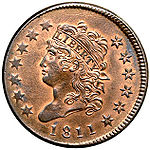 | 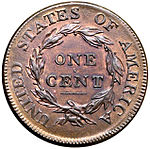 | 10,89 | ~ 29 | płaska | miedź |
| Coronet Head[a] | 1816–1857 |  | 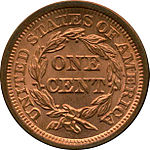 | 10,89 | 28–29 | płaska | miedź |
Miedzioniklowe
Lista wszystkich miedzioniklowych monet o nominale 1 centa[11]:
| Typy | Lata emisji | Wizerunek | Charakterystyka | ||||
|---|---|---|---|---|---|---|---|
| awers | rewers | waga (g) | średnica (mm) | krawędź | stop | ||
| Flying Eagle | 1856–1858 | 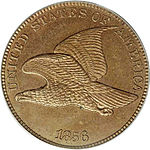 |  | 4,67 | 19 | płaska | 88% miedź, 12% nikiel |
| Indian Head | 1859 |  |  | 4,67 | 19 | płaska | 88% miedź, 12% nikiel |
| 1860–1864 | 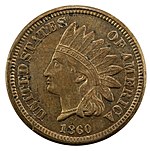 |  | |||||
Brązowe
Lista wszystkich monet o nominale 1 centa wybitych w brązie[12]:
Stal pokryta cynkiem
Lista wszystkich monet o nominale 1 centa wybitych w stali pokrytej cynkiem[7]:
| Typy | Lata emisji | Wizerunek | Charakterystyka | ||||
|---|---|---|---|---|---|---|---|
| awers | rewers | waga (g) | średnica (mm) | krawędź | stop | ||
| Lincoln | 1943 |  | 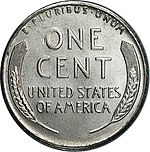 | 2,7 | 19 | płaska | stal pokryta cynkiem |
Cynk pokryty miedzią
Lista wszystkich monet o nominale 1 centa wybitych w cynku pokrytym miedzią[13][14]:
| Typy | Lata emisji | Wizerunek | Charakterystyka | ||||
|---|---|---|---|---|---|---|---|
| awers | rewers | waga (g) | średnica (mm) | krawędź | stop | ||
| Lincoln | 1982–2008 |  | 2,5 | 19 | płaska | cynk pokryty miedzią | |
| 2009[b] | cztery najważniejsze wydarzenia z życia Lincolna | ||||||
| od 2010 | |||||||
2 centy
Wprowadzenie dwucentówek na mocy Coinage Act of 1864(ang.) miało na celu przeciwdziałanie niedoborowi gotówki w obiegu, który pojawił się wskutek tezauryzacji pieniądza podczas wojny secesyjnej[15].
Lista wszystkich monet o nominale 2 centów[16]:
| Typy | Lata emisji | Wizerunek | Charakterystyka | ||||
|---|---|---|---|---|---|---|---|
| awers | rewers | waga (g) | średnica (mm) | krawędź | stop | ||
| Shield Two Cents | 1864–1873 |  |  | 6,22 | 23 | gładka | 95% miedź, 5% cyna i cynk |
3 centy
Srebrne
Kalifornijska gorączka złota doprowadziła do pojawienia się na rynku dużych ilości złota. Doprowadziło to do obniżenia wartości tego kruszcu w stosunku do srebra, które okazało się znaczniej bardziej wartościowe jako kruszec niż jako monety. W związku z tym wiele monet było ściąganych z obiegu i przetapianych. Politycy nie chcieli wprowadzać na rynek pieniądza fiducjarnego. Dlatego postanowiono wprowadzić do obiegu monetę, która zawierałaby wystarczającą ilość srebra, aby uznać ją za kruszcową, natomiast domieszka miedzi miała zniechęcić do przetopu. W ten sposób Kongres wprowadził w 1851 roku srebrną trzycentówkę[17].
Lista wszystkich monet o nominale 3 centów wybitych w srebrze[18]:
Miedzioniklowe
W związku z gromadzeniem monet z metali szlachetnych przez ludność w okresie wojny secesyjnej i koniecznością wymiany bonów zdawkowych (ang. fractional currency), wprowadzono miedzionklowe trzycentówki. Początkowo były one bite równocześnie ze srebrnymi monetami o tym nominale. Jednakże z czasem monety srebrne zaczęły ponownie pojawiać się w obiegu, ilość wymienianych bonów zdawkowych malała, a w 1883 roku stawka podstawowej opłaty pocztowej została obniżona do 2 centów. Czynniki te, wraz z dużymi zapasami monet jedno- i pięciocentowych doprowadziły do zakończenia bicia monet o tym nominale[19]. Miedzioniklowe trzycentówki popularnie zwane są niklowymi jedynie ze względu na swój kolor[20].
Lista wszystkich monet o nominale 3 centów wybitych w miedzioniklu[21]:
| Typy | Lata emisji | Wizerunek | Charakterystyka | ||||
|---|---|---|---|---|---|---|---|
| awers | rewers | waga (g) | średnica (mm) | krawędź | stop | ||
| Nickel Three Cents | 1865–1889 |  |  | 1,94 | 17,9 | gładka | 75% miedź, 25% nikiel |
5 centów
Pomimo że monety 5-centowe zostały ustanowione na mocy Coinage Act of 1792, to ich bicie i emisję rozpoczęto w 1795 roku (niektóre z monet wówczas wybitych posiadały wsteczną datę 1794[22]). Do 1837 roku monety o tym nominale ważyły 20,8 granów (1,347 g) i były wybijane na krążkach ze srebra próby 892. W 1837 roku zmieniono wagę monet na 20⅝ grana (1,336 g), a próbę srebra zwiększono do 900. W 1853 roku wagę monety zmniejszono do 19,2 granów (1,24 g)[23]. W trakcie wojny secesyjnej monety srebrne i złote były gromadzone przez Amerykanów w ramach zabezpieczenia. Włądze federalne zmuszone były do uzupełnienia braków monety na rynku poprzez emisję miedzioniklowych (zwanych niklowymi ze względu na kolor) monet zastępczych. Skłoniło to dyrektora U.S. Mint Jamesa Pollocka do zmiany metalu, z którego wybijano monety. Pięciocentówka Shield była pierwszą wybitą w miedzioniklu[24].
Monety pięciocentowe z 1883 roku, które nie posiadały nominału na rewersie, tzw. racketeer nickels (pięciocentówki oszustów), miały być pokrywane złotem. Ze względu na podobny projekt awersu i rozmiar miano je wypuszczać do obiegu jako pięciodolarówki. Historia ta nie została jednak potwierdzona[25].
W trakcie wojny nikiel był szeroko wykorzystywany w przemyśle zbrojeniowym. W 1942 roku Kongres zakazał używania tego metalu w mennictwie. W zamian za to postanowiono użyć stopu srebra, miedzi i manganu. Uważano, że zaraz po wojnie zostaną wycofane z obiegu. Moneta ta jednak cieszyła się dużą popularnością, a w latach 60. XX wieku zaczęły znikać z obiegu z racji na rosnące ceny srebra[26].
Srebrne
Lista wszystkich srebrnych monet o nominale 5 centów[27]:
Miedzioniklowe
Lista wszystkich miedzioniklowych monet o nominale 5 centów[28]:
| Typy | Lata emisji | Wizerunek | Charakterystyka | ||||
|---|---|---|---|---|---|---|---|
| awers | rewers | waga (g) | średnica (mm) | krawędź | stop | ||
| Shield | 1866–1867 |  |  | 5 | 20,5 | płaska | 75% miedź, 25% nikiel |
| 1867–1883 | 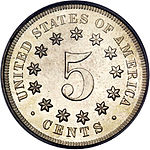 | ||||||
| Liberty Head | 1883 |  |  | 5 | 21,2 | płaska | 75% miedź, 25% nikiel |
| 1883–1913 | 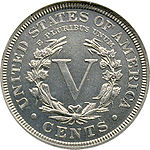 | ||||||
| Buffalo | 1913–1938 |  | 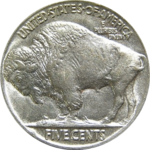 | 5 | 21,2 | płaska | 75% miedź, 25% nikiel |
| Jefferson | 1938–1942 1946–2003 |  |  | 5 | 21,2 | płaska | 75% miedź, 25% nikiel |
| 2004–2005[c] | Awers niezmieniony, 4 różne rewersy związane z wyprawą Lewisa i Clarka[d] | ||||||
| od 2006 | Zmieniony awers monety, pozostawiony rewers Monticello[e] | ||||||
Stop srebra, miedzi i manganu
Moneta o nominale 5 centów wybitych w stopie srebra, miedzi i manganu[29]:
| Typy | Lata emisji | Wizerunek | Charakterystyka | ||||
|---|---|---|---|---|---|---|---|
| awers | rewers | waga (g) | średnica (mm) | krawędź | stop | ||
| Jefferson | 1942–1945 | (c) Photo taken by user bobby131313 and may be used freely with following credit. Image courtesy of CCF Numismatics, CC BY-SA 3.0 | 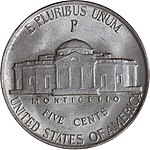 | 5 | 21,2 | płaska | 56% miedź, 35% srebro, 9% mangan |
10 centów
Moneta dziesięciocentowa stanowiła istotną część systemu monetarnego Stanów Zjednoczonych. Spośród wszystkich nominałów wprowadzonych na mocy Coinage Act of 1792 nominał ten został najpóźniej wyemitowany, ponieważ dopiero w 1796 roku. Monety dziesięciocentowe były wybijane w srebrze aż do 1965 roku[30][31]. Wtedy też rozpoczęto emisję monet miedzioniklowych ze względu na wycofanie srebra z mennictwa obiegowego przez Kongres w 1964 roku[31][32].
Srebrne
Lista wszystkich monet o nominale 10 centów wybitych w srebrze[33]:
| Typy | Lata emisji | Wizerunek | Charakterystyka | ||||
|---|---|---|---|---|---|---|---|
| awers | rewers | waga (g) | średnica (mm) | krawędź | stop | ||
| Draped Bust | 1796–1797 | 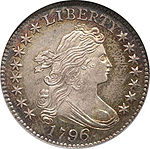 |  | 2,7 | ~ 19 | ząbkowana | 89,24% srebro, 10,76 miedź |
| 1798–1807 |  | ||||||
| Capped Bust | 1809–1837 |  |  | 2,7 | 18,8 (1809–1827) 18,5 (1828–1837) | ząbkowana | 89,24% srebro, 10,76 miedź |
| Seated Liberty | 1837–1838 |  |  | 2,67 | 17,9 | ząbkowana | 90% srebro, 10% miedź |
| 1838–1853 |  |  | |||||
| 1853–1855 | 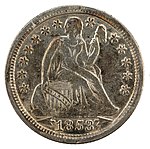 |  | 2,49 | ||||
| 1860–1873 1875–1891 |  |  | |||||
| 1873–1874 |  | 2,5 | |||||
| Barber | 1892–1916 |  | 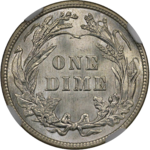 | 2,5 | 17,9 | ząbkowana | 90% srebro, 10% miedź |
| Mercury[f] | 1916–1945 | 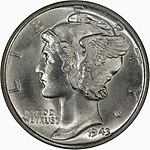 | 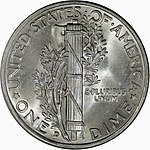 | 2,5 | 17,9 | ząbkowana | 90% srebro, 10% miedź |
| Roosevelt | 1946–1965 |  |  | 2,5 | 17,9 | ząbkowana | 90% srebro, 10% miedź |
Miedzioniklowe
Lista wszystkich monet o nominale 10 centów wybitych w miedzioniklu[34]:
| Typy | Lata emisji | Wizerunek | Charakterystyka | ||||
|---|---|---|---|---|---|---|---|
| awers | rewers | waga (g) | średnica (mm) | krawędź | stop | ||
| Roosevelt | od 1965 |  |  | 2,27 | 17,9 | ząbkowana | miedź pokryta miedzioniklem |
20 centów
Celem ochrony interesów właścicieli kopalni srebra, którzy skarżyli się na spadek popytu na wydobywany przez siebie kruszec w następstwie zakończenia emisji srebrnych trzycentówek, pięciocentówek oraz dolarów, podjęto decyzję o rozpoczęciu bicia monet dwudziestocentowych w srebrze. Była to decyzja o charakterze politycznym, która miała być odpowiedzią na niedobór drobnej monety występujący wówczas głównie na zachodzie Stanów Zjednoczonych. Monety tego nominału nie cieszyły się popularnością wśród ludności ze względu na fakt, że łatwo było pomylić je z ćwierćdolarówkami, jako że posiadały podobną wielkość i stylistykę[35].
Lista wszystkich monet o nominale 20 centów[36]:
| Typy | Lata emisji | Wizerunek | Charakterystyka | ||||
|---|---|---|---|---|---|---|---|
| awers | rewers | waga (g) | średnica (mm) | krawędź | stop | ||
| Liberty Seated | 1875–1878 |  |  | 5 | 22 | gładka | 90% srebro, 10 miedź |
25 centów
Mimo ustanowienia monet o nominale 25 centów (quarter dollar) w 1792 roku, to pierwsza ćwierćdolarówka zostało wyemitowana w 1796 roku. W 1804 roku na rewersie wprowadzono nominał zapisany jako „25c”. Do 1837 roku jedna moneta o tym nominale miała wagę równą 104 granów (6,73 g). Od 1837 roku waga monety została zredukowana do 103⅛ grana (6,68 g). W 1873 roku zwiększono mase monety[37].
W 1964 roku Kongres wycofał srebro z obiegowego mennictwa w Stanach Zjednoczonych. Od tej pory ćwierćdolarówki wybijane są w miedzioniklu[32].
Srebrne
Lista wszystkich srebrnych monet o nominale 25 centów[38]:
| Typy | Lata emisji | Wizerunek | Charakterystyka | ||||
|---|---|---|---|---|---|---|---|
| awers | rewers | waga (g) | średnica (mm) | krawędź | stop | ||
| Draped Bust | 1796 | 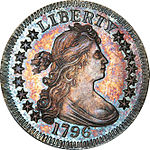 | 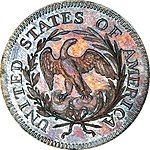 | 6,74 | ~ 27,5 | ząbkowana | 89,24% srebro, 10,76 miedź |
| 1804–1807 |  | ||||||
| Capped Bust[g] | 1815–1838 |  |  | 6,74 | ~ 27 | ząbkowana | 89,24% srebro, 10,76 miedź |
| Seated Liberty | 1838–1853 1856–1865 | 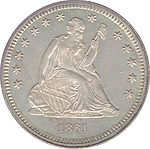 | 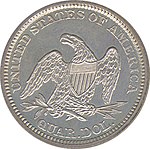 | 6,68 | 24,3 | ząbkowana | 90% srebro, 10 miedź |
| 1853 |  |  | 6,22 | ||||
| 1854–1855 | 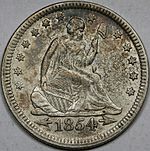 |  | |||||
| 1866–1873 1875–1891 | 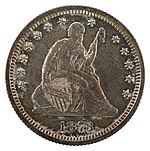 |  | |||||
| 1873–1874 |  | 6,25 | |||||
| Barber[h] | 1892–1916 |  |  | 6,25 | 24,3 | ząbkowana | 90% srebro, 10 miedź |
| Standing Liberty | 1916–1917 |  |  | 6,25 | 24,3 | ząbkowana | 90% srebro, 10 miedź |
| 1917–1930 |  |  | |||||
| Washington | 1932–1964 | 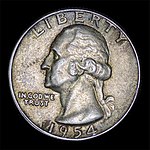 |  | 6,25 | 24,3 | ząbkowana | 90% srebro, 10 miedź |
Miedź pokryta miedzioniklem
Lista wszystkich miedzioniklowych monet o nominale 25 centów[39]:
| Typy | Lata emisji | Wizerunek | Charakterystyka | ||||
|---|---|---|---|---|---|---|---|
| awers | rewers | waga (g) | średnica (mm) | krawędź | stop | ||
| Washington | 1965–1974 1977–1998 |  | 5,67 | 24,3 | ząbkowana | miedź pokryta miedzioniklem | |
| Bicentennial quarter | 1976 |  | 5,67 | 24,3 | ząbkowana | miedź pokryta miedzioniklem | |
| 50 State Quarters | 1999–2008 |  | odniesienia do poszczególnych stanów | 5,67 | 24,3 | ząbkowana | miedź pokryta miedzioniklem |
| District of Columbia and United States Territories Quarters | 2009 |  | 6 różnych rewersów | 5,67 | 24,3 | ząbkowana | miedź pokryta miedzioniklem |
| America the Beautiful Quarters | od 2010 |  | amerykańskie parki narodowe i miejsca związane z historią i dziedzictwem narodu | 5,67 | 24,3 | ząbkowana | miedź pokryta miedzioniklem |
50 centów
Monety o nominale 50 centów ustanowiono na mocy Coinage Act of 1792. Pierwszą pięćdziesięciocentówkę wyemitowano w 1794 roku. Do 1837 roku monety te miały wagę 208 granów (13,47 g), a srebro próbę 892. W 1837 roku wagę zredukowano do 206¼ grana, a próbę srebra podniesiono do 900, którą utrzymano aż do 1965 roku. W 1853 roku z racji, iż monety o nominale 50 centów były warte więcej niż kruszec, z którego je wybijano, to postanowiono zredukować wagę monet do 192 granów (12,44 g). W 1873 roku, na mocy Coinage Act of 1873, wstrzymano bicie monet jednodolarowych jako monety obiegowej na terenie Stanów Zjednoczonych, a także zniesiono bimetalizm. 50 centów stało się najwyższym nominałem, a masę zwiększono do 192,9 granów (12,49 g)[40][41]. W 1964 roku Kongres wycofał srebro z mennictwa obiegowego[32]. Jednak w przypadku monet o nominale 50 centów z wizerunkiem prezydenta Johna F. Kennedy’ego osiągnięto porozumienie i do 1970 roku wybijano monety o miedzianym wnętrzu otoczonym srebrem[42].
Srebrne
Lista wszystkich srebrnych monet o nominale 50 centów[43]:
| Typy | Lata emisji | Wizerunek | Charakterystyka | ||||
|---|---|---|---|---|---|---|---|
| awers | rewers | waga (g) | średnica (mm) | krawędź | stop | ||
| Flowing Hair | 1794–1795 |  |  | 13,47 | 32,5 | z napisem „FIFTY CENTS OR A HALF DOLLAR” | 89,24% srebro, 10,76% miedź |
| Draped Bust | 1796–1797 |  |  | 13,47 | 32,5 | z napisem „FIFTY CENTS OR A HALF DOLLAR” | 89,24% srebro, 10,76% miedź |
| 1801–1807 |  | ||||||
| Capped Bust | 1807–1836 |  |  | 13,47 | 32,5 | z napisem „FIFTY CENTS OR A HALF DOLLAR” (1807–1814) dodano ★ pomiędzy DOLLAR i FIFTY (1814–1831) pionowe linie pomiędzy słowami (1832–1836) | 89,24% srebro, 10,76% miedź |
| 1836–1837 | nominał „50 CENTS”[i] | 13,36 | 30 | ząbkowana | 90% srebro, 10% miedź | ||
| 1838–1839 | nominał „HALF DOL.”[j] | ||||||
| Seated Liberty | 1839–1853 |  |  | 13,36 | 30,6 | ząbkowana | 90% srebro, 10% miedź |
| 1853 | Strzałki przy dacie[k] | Promienie wokół orła[l] | 12,44 | ||||
| 1854–1855 | Bez strzałek przy dacie | Bez promieni wokół orła | |||||
| 1856–1866 |  |  | |||||
| 1866–1874 1875–1891 |  |  | |||||
| 1873–1874 | 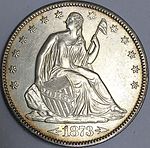 | 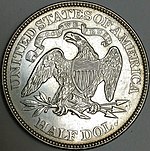 | 12,49 | ||||
| Barber[m] | 1892–1915 |  |  | 12,49 | 30,6 | ząbkowana | 90% srebro, 10% miedź |
| Walking Liberty | 1916–1947 |  |  | 12,49 | 30,6 | ząbkowana | 90% srebro, 10% miedź |
| Franklin | 1948–1963 |  |  | 12,49 | 30,6 | ząbkowana | 90% srebro, 10% miedź |
| Kennedy | 1964 |  | 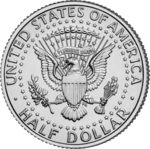 | 12,49 | 30,6 | ząbkowana | 90% srebro, 10% miedź |
| 1965–1970 | 11,50 | 80% srebro, 20% miedź (zewnętrzna powłoka) 20,9% srebro, 79,1% miedź (wnętrze monety) | |||||
Miedzioniklowe
Lista wszystkich miedzioniklowych monet o nominale 50 centów[44]:
| Typy | Lata emisji | Wizerunek | Charakterystyka | ||||
|---|---|---|---|---|---|---|---|
| awers | rewers | waga (g) | średnica (mm) | krawędź | stop | ||
| Kennedy | od 1971 |  |  | 11,34 | 30,6 | ząbkowana | miedź pokryta miedzioniklem |
| 1975–1976 |  | ||||||
1 dolar
Złote dolary
Bicie złotych dolarów ustanowiono na mocy Coinage Act of 1792. Od 1935 roku do 31 grudnia 1974 roku posiadanie złota przez obywateli amerykańskich było zabronione[45].
Lista wszystkich złotych dolarów[46]:
Srebrne dolary
Bicie srebrnych dolarów ustanowiono na mocy Coinage Act of 1792[47]. W 1964 roku Kongres zadecydował o tym, że wypłata srebrnych dolarów zostaje wstrzymana. Rok później uchwalony Coinage Act of 1965 zawierał zapis o tym, iż obiegowe monety nie będą już wybijane w srebrze. W 1970 roku Kongres uchwalił prawo, które nakazywało wybicie 150 mln posrebrzanych monet, ale już wyłącznie dla kolekcjonerów[48].
Lista wszystkich srebrnych dolarów[49]:
| Typy | Lata emisji | Wizerunek | Charakterystyka | ||||
|---|---|---|---|---|---|---|---|
| awers | rewers | waga (g) | średnica (mm) | krawędź | stop | ||
| Dolar Flowing Hair | 1794–1795 |  |  | 26,96 | 39–40 | z napisem „HUNDRED CENTS ONE DOLLAR OR UNIT” | 89,2% srebro, 10,8% miedź (zgodnie z prawem) 90% srebro, 10 miedź (wg decyzji A. Coxa) |
| Dolar Draped Bust | 1795–1803 |  |  | 26,96 | 39–40 | z napisem „HUNDRED CENTS ONE DOLLAR OR UNIT” | 89,2% srebro, 10,8% miedź |
 | |||||||
| Dolar Gobrechta | 1836–1839 |  |  | 26,95 (do 1837) 26,72 | 39–40 | gładka i ząbkowana | 89,24% srebro, 10,76% miedź (do 1837) 90% srebro, 10% miedź |
 |  | ||||||
| Dolar Seated Liberty | 1840–1866 | 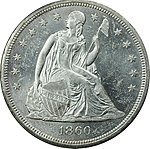 | 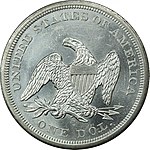 | 26,73 | 38,1 | ząbkowana | 90% srebro, 10% miedź |
| 1866–1873 | 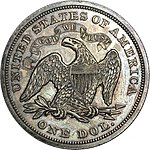 | ||||||
| Trade Dollar | 1873–1885[n] |  |  | 27,22 | 38,1 | ząbkowana | 90% srebro, 10% miedź |
| Dolar Morgana | 1878–1904 |  | 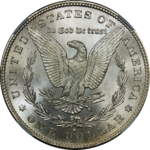 | 26,73 | 38,1 | ząbkowana | 90% srebro, 10% miedź |
| Dolar Pokoju | 1921–1928 1934–1935 |  |  | 26,73 | 38,1 | ząbkowana | 90% srebro, 10% miedź |
Dolary miedzioniklowe
Od 1965 roku w Stanach Zjednoczonych nie wybijało się już srebrnych obiegowych monet jednodolarowych. W 1970 roku uchwalono usatwę, która ustanowiła monetę jednodolarową, która miałaby jednocześnie upamiętnić wojskowego i prezydenta Stanów Zjednoczonych Dwighta Eisenhowera oraz misję Apollo 11. W 1975 roku rozpocząto emisję dolarów Eisenhowera z okazji 200. rocznicy niepodległości Stanów Zjednoczonych[48].
W 1978 roku Kongres uchwalił ustawę, która nakazywałaby emisje monety jednodolarowej różniącej się od wszystkich poprzednich emisji. Decyzja ta poparta była raportem Departamentu Skarbu, który informował, że Amerykanie niechętnie używają monety jednodolarowej ze względu na zbyt duży rozmiar i wagę. Ponadto nowa moneta miała wyprzeć z obiegu banknot o tym samym nominale[50].
Lista wszystkich miedzioniklowych dolarów[51]:
Tzw. golden dollars
Wprowadzenie do obiegu dolara Susan B. Anthony okazało się niepowodzeniem. Władze federalne chciały zastąpić w obiegu banknoty jednodolarowe monetami o tym samym nominale. Jednak podobieństwo monet do ćwierćdolarówek sprawiło, że Amerykanie woleli dalej używać banknotów. W 1997 roku uchwalono prawo nakazujące wybór dla monety jednodolarowej charakterystycznego i wyróżniającego wizerunku. W tym celu na awersie monety postanowiono upamiętnić Indiankę z plemienia Szoszonów, która miała pomagać Meriwetherowi Lewisowi i Williamowi Clarkowi podczas ich wyprawy w latach 1804–1806. Od 2009 roku co rok zmienainy jest wizerunek awersu, aby upamiętnić ważne dla amerykańskich Indian wydarzenia lub podkreślić ich wkład w rozwój Stanów Zjednoczonych[52][53].
W 2005 roku prezydent George W. Bush podpisał Presidential $1 Coin Act of 2005, który miał na celu wprowadzenie do obiegu monet jednodolarowych upamiętniających prezydentów Stanów Zjednoczonych. Założono, że co roku emitowana będzie jedna moneta[54][55].
| Typy | Lata emisji | Wizerunek | Charakterystyka | ||||
|---|---|---|---|---|---|---|---|
| awers | rewers | waga (g) | średnica (mm) | krawędź | stop | ||
| Dolar Sacagawea | 2000–2008 | Sacagawea z dzieckiem na plecach[o] |  | 8,1 | 26,5 | gładka | miedź platerowana mosiądzem |
| od 2009 | różne rewersy honorujące Indian i ich wkład w historię Stanów Zjednoczonych | ||||||
| Dolary prezydenckie | 2007–2020 | twarze prezydentów |  | 8,1 | 26,5 | z napisami„E PLURIBUS UNUM” i „IN GOD WE TRUST” | miedź platerowana mosiądzem |
2½ dolara
Monety o nominale 2½ dolara amerykańskiego (tzw. Quarter Eagle) zostały ustanowione na mocy Coinage Act of 1792. Poczatkowo były bite ze złota próby 916, od 1834 roku próbę zmieniono na 899, a od 1837 próbę tą zwiększono do 900[56].
Lista wszystkich monet Quarter Eagle[57]:
| Typy | Lata emisji | Wizerunek | Charakterystyka | ||||
|---|---|---|---|---|---|---|---|
| awers | rewers | waga (g) | średnica (mm) | krawędź | stop | ||
| Draped Bust Quarter Eagle[p] | 1796 |  |  | 4,37 | 20 | ząbkowana | 91,67% złoto, 8,33% miedź |
| 1796–1807 |  | ||||||
| Capped Bust Quarter Eagle[q] | 1808 |  |  | 4,37 | 20 | ząbkowana | 91,67% złoto, 8,33% miedź |
| 1821–1834 |  | 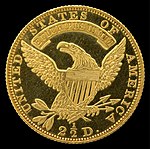 | 4,37 | 20 (do 1829) 18,5 (w 1829) 18,2 (od 1829) | ząbkowana | 91,67% złoto, 8,33% miedź | |
| Classic Head Quarter Eagle | 1834–1839 | 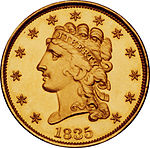 | 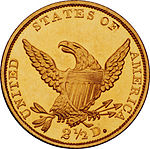 | 4,18 | 18,2 | ząbkowana | 89,92% złoto, 10,08 miedź |
| Liberty Head Quarter Eagle | 1840–1907 |  | 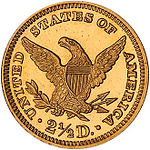 | 4,18 | 18 | ząbkowana | 90% złoto, 10% miedź |
| Indian Head Quarter Eagle | 1908–1929 | 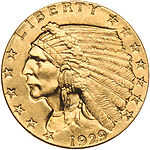 | 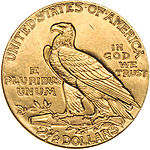 | 4,18 | 18 | ząbkowana | 90% złoto, 10% miedź |
Ponadto istnieją dwie okolicznościowe monety o tym nominale, z lat 1915 (Panama Pacific Expo) i 1926 (600-lecie Filadelfii).
3 dolary
Złote monety trzydolarowe zostały wprowadzone do użytku na mocy Coinage Act of 1853(ang.). Powody ustanowienia tego nominału nie są znane. Według różnych teorii miały w być używane do dokonywania zakupów arkuszy stu znaczków pocztowych (po cenie 3 centów za jeden) lub miały ułatwić zakup większych ilości wprowadzonych trzy lata wcześniej monet trzycentowych[58][59].
Lista wszystkich monet o nominale 3 dolarów[60]:
| Typy | Lata emisji | Wizerunek | Charakterystyka | ||||
|---|---|---|---|---|---|---|---|
| awers | rewers | waga (g) | średnica (mm) | krawędź | stop | ||
| Indian Princess | 1854–1855 |  |  | 5,015 | 20,5 | ząbkowana | 90% złoto, 10% miedź |
| 1855–1889 |  | ||||||
5 dolarów
2 kwietnia 1792 roku Kongres uchwalił Coinage Act of 1792, który zezwolił na bicie monet kilku denominacji, w tym właśnie monet złotych o nominale pięciu dolarów amerykańskich zwanych Half Eagle. Była to wówczas druga moneta co do wartości w Stanach Zjednoczonych, większy nominał miały tylko monety Eagle[61].
Lista wszystkich monet o nominale 5 dolarów[62]:
| 1907–1908 | Lata emisji | Wizerunek | Charakterystyka | |||
|---|---|---|---|---|---|---|
| waga (g) | średnica (mm) | krawędź | stop | |||
| Draped Bust Half Eagle[r] | 1795–1798 |  | 8,75 | 25 | ząbkowana | 91,67% złoto, 8,33% miedź |
| 1798–1807 |  | |||||
| Capped Bust Half Eagle[s] | 1807–1812 |  | 8,74 | 25 | ząbkowana | 91,67% złoto, 8,33% miedź |
| 1813–1834 |  | 25 (1813–1829) 22,5 (1829–1834) | ||||
| Classic Head Half Eagle | 1834–1838 |  | 8,35 | 22,5 | ząbkowana | 89,9% złoto, 10,1% miedź |
| Liberty Head Half Eagle[t] | 1839–1866 |  | 8,35 | 22,5 (1839–1840) | ząbkowana | 90% złoto, 10% miedź |
| 21,6 (1840–1908) | ||||||
| 1866–1908 |  | |||||
| Indian Head Half Eagle | 1907–1908 |  | 8,35 | 21,6 | ząbkowana | 90% złoto, 10% miedź |
10 dolarów
Złote monety zwane Eagle zostały ustanowione przez Kongres na mocy Coinage Act of 1792. Od roku 1804 do 1838 emisja złotych monet dziesięciodolarowych była wstrzymana ze względu na to, że na przełomie XVIII i XIX wieku złote monety były wyprowadzane poza granice Stanów Zjednoczonych lub przetapiane w kraju poza wiedzą mennicy. Złote mennictwo w Stanach Zjednoczonych zostało wstrzymane przez prezydenta Franklina D. Roosevelta 5 kwietnia 1933 roku, kiedy nakazał zwrot złotych monet do Rezerwy Federalnej. Wyjątkiem było posiadanie walorów o wartości kolekcjonerskiej. 30 stycznia 1934 roku wszedł w życie Gold Reserve Act, który ostatecznie wycofał złoto z obiegu, wstrzymał pokrycie dla pieniądza papierowego w tym kruszcu i nakazał przetopienie go w sztaby[63].
Lista wszystkich monet o nominale 10 dolarów[64]:
20 dolarów
Istotny wpływ na złote mennictwo w Stanach Zjednoczonych miała kalifornijska gorączka złota. Doprowadziło to do sytuacji, w której srebro sprzedawano na rynku z dużym zyskiem. Napływ złota na rynek sprawił, że srebro, którego ceny były liczone w złocie, stało się niedowartościowane. Srebrne jednodolarówki okazały się być bardziej wartościowe niż ich wartość nominalna. 20 lutego przedstawiono projekt ustawy będącej połączeniem wcześniejszych propozycji reformy systemu monetarnego Jamesa McKaya i Charlesa G. Athertona. Została ona zaakceptowana przez Izbę Reprezentantów. Senat przyjął ustawę pod nazwą Coinage Act of 1849(ang.) 3 marca 1849 roku, ustanawiając monetę o nominale 20 dolarów. Głównym zamysłem, który stanowił podwaliny pod wprowadzenie monety Double Eagle, była chęć przekształcenia dużych ilości złota na rynku w monety przy jak najmniejszym wysiłku mennic[65].
Lista wszystkich monet o nominale 20 dolarów[66]:
Uwagi
- ↑ Znana także jako Liberty Head.
- ↑ Emisja na 200. rocznicę urodzin Lincolna i 100. rocznicę początku emisji centa Lincolna.
- ↑ Emisja z okazji 200. rocznicy wyprawy Lewisa i Clarka.
- ↑ Zobacz wizerunki monet.
- ↑ Zobacz wizerunek monety.
- ↑ Znana także jako Winged Liberty.
- ↑ Znana także jako Liberty Cap.
- ↑ Znana także jako Liberty Head.
- ↑ Zobacz wizerunek rewersu.
- ↑ Zobacz wizerunek rewersu.
- ↑ Zobacz wizerunek awersu.
- ↑ Zobacz wizerunek rewersu.
- ↑ Znana również jako Liberty Head.
- ↑ Prawo ustanawiające monetę w 1873 roku nadało jej status legalnego środka płatniczego w wartości do 5 dolarów amerykańskich. Uczyniono to ze względów wizerunkowych, aby wpłynęło to na renomę monety w Azji. Ustawodawcy nie przewidywali, że moneta może wejść do amerykańskiego obiegu. W 1876 roku z powodu rosnącego napływu tej monety na rynek amerykański zawieszono jej status jako legalnego środka płatniczego na terenie Stanów Zjednoczonych. W 1878 roku Departament Skarbu Stanów Zjednoczonych wstrzymał ostatecznie bicie dolara handlowego na potrzeby rynkowe.
- ↑ Zobacz wizerunek awersu.
- ↑ Znana również jako Capped Bust to right.
- ↑ Znana również jako Capped Bust to left, Turban Head Quarter Eagle.
- ↑ Znana również jako Capped Bust to the right lub Turban Head.
- ↑ Znana również jako Capped Bust to the left.
- ↑ Znana również jako Braided Hair lub Coronet Head.
Przypisy
- ↑ Liberty Cap Half Cents (1793-1797), „NGC” [dostęp 2022-11-10].
- ↑ Yeoman 2009 ↓, s. 87–92.
- ↑ Yeoman 2009 ↓, s. 93.
- ↑ Yeoman 2009 ↓, s. 108–109.
- ↑ Flying Eagle Cents (1856-1858), „NGC” [dostęp 2022-11-24].
- ↑ Yeoman 2009 ↓, s. 111.
- ↑ a b Yeoman 2009 ↓, s. 116.
- ↑ Yeoman 2009 ↓, s. 118.
- ↑ Yeoman 2009 ↓, s. 120.
- ↑ Yeoman 2009 ↓, s. 93–108, 111, 113.
- ↑ Yeoman 2009 ↓, s. 109–110.
- ↑ Yeoman 2009 ↓, s. 111, 113, 116, 118.
- ↑ Yeoman 2009 ↓, s. 120–121.
- ↑ Lincoln Cents, Bicentennial and Shield Reverse (2009-Date), „NGC” [dostęp 2022-11-24].
- ↑ Shield Two Cents (1864-1873), „NGC” [dostęp 2022-11-10].
- ↑ Yeoman 2009 ↓, s. 122.
- ↑ Silver Three Cents (1851-1873), „NGC” [dostęp 2022-11-10].
- ↑ Yeoman 2009 ↓, s. 123.
- ↑ Nickel Three Cents (1865-1889), „NGC” [dostęp 2022-11-10].
- ↑ Three Cent Nickel, „PCGS” [dostęp 2022-11-10].
- ↑ Yeoman 2009 ↓, s. 124.
- ↑ History of the 1792 Half Disme, „NGC” [dostęp 2022-11-29].
- ↑ Yeoman 2009 ↓, s. 136.
- ↑ Shield Five Cents (1866-1883), „NGC” [dostęp 2022-11-29].
- ↑ Daley 2016 ↓.
- ↑ Jefferson Five Cents (1938-Date), „NGC” [dostęp 2022-11-29].
- ↑ Yeoman 2009 ↓, s. 136–141.
- ↑ Yeoman 2009 ↓, s. 125–135.
- ↑ Yeoman 2009 ↓, s. 130.
- ↑ Early Dimes (1796-1837), „NGC” [dostęp 2022-11-17].
- ↑ a b Roosevelt Dimes (1946-Date), „NGC” [dostęp 2022-11-17].
- ↑ a b c Westeyn 2021 ↓.
- ↑ Yeoman 2009 ↓, s. 142–154.
- ↑ Yeoman 2009 ↓, s. 156.
- ↑ Twenty Cents (1875-1878), „NGC” [dostęp 2022-11-10].
- ↑ Yeoman 2009 ↓, s. 158.
- ↑ Yeoman 2009 ↓, s. 159.
- ↑ Yeoman 2009 ↓, s. 159–170.
- ↑ Yeoman 2009 ↓, s. 172–182.
- ↑ Yeoman 2009 ↓, s. 183.
- ↑ Coulson ↓.
- ↑ Kennedy Half Dollars (1964-Date), „NGC” [dostęp 2022-11-20].
- ↑ Yeoman 2009 ↓, s. 183–203.
- ↑ Yeoman 2009 ↓, s. 202–205.
- ↑ Yeoman 2009 ↓, s. 230.
- ↑ Yeoman 2009 ↓, s. 230–232.
- ↑ Yeoman 2009 ↓, s. 206.
- ↑ a b Eisenhower Dollars (1971-1978), „NGC” [dostęp 2022-11-16].
- ↑ Yeoman 2009 ↓, s. 206–225.
- ↑ Anthony Dollars (1979-1999), „NGC” [dostęp 2022-11-17].
- ↑ Yeoman 2009 ↓, s. 223–226.
- ↑ Sacagawea Dollars (2000-Date), „NGC” [dostęp 2022-11-16].
- ↑ Native American & Sacagawea Dollars, „USA Coin Book” [dostęp 2022-11-16].
- ↑ Presidential Dollars (2007-2020), „NGC” [dostęp 2022-11-16].
- ↑ Presidential Dollars, „USA Coin Book” [dostęp 2022-11-16].
- ↑ Yeoman 2009 ↓, s. 233.
- ↑ Yeoman 2009 ↓, s. 233–239.
- ↑ Three Dollar Gold (1854-1889), „NGC” [dostęp 2022-11-10].
- ↑ Bowers 1986 ↓, s. 206.
- ↑ Yeoman 2009 ↓, s. 241.
- ↑ Bowers 1982 ↓, s. 297.
- ↑ Yeoman 2009 ↓, s. 243–254.
- ↑ Bowers ↓, s. 29, 32, 273–274.
- ↑ Yeoman 2009 ↓, s. 255–262.
- ↑ Bowers 1982 ↓, s. 297–298.
- ↑ Yeoman 2009 ↓, s. 263–271.
Bibliografia
- David Bowers, United States Gold Coins: An Illustrated History, Los Angeles-Wolfeboro: Bowers and Ruddy Galleries, Inc., 1982, ISBN 0-914490-21-4 [dostęp 2022-09-07].
- David Bowers, United States Coins by Design Types, Wolfeboro: Bowers and Merena Galleries, Inc., 1986 [dostęp 2022-10-24].
- Thomas Coulson, Collecting Liberty Seated Dollars, „Liberty Coin Service” [dostęp 2022-11-20].
- Jason Daley, A Brief History of the Racketeer Nickel, „Smithsonian Magazine”, 17 listopada 2016 [dostęp 2022-11-28].
- Jill Westeyn, One Hundred Years of Silver Dollar Coinage (1878-1978), „U.S. Mint”, 15 kwietnia 2021 [dostęp 2022-11-17].
- R.S. Yeoman, A Guide Book of United States Coins, wyd. 63, Atlanta: Whitman Publising, LLC, 2009, ISBN 978-0-7948-2766-3.
Media użyte na tej stronie
1807 G$5 Capped Bust
Gold (fineness 0.9160), 25mm, 8.75g, designed by Reich
JN2015-6736-37
1860-O Seated Liberty dollar obverse
1796 Quarter Dollar, Draped Bust, Reverse
1807 Quarter Dollar, Draped Bust, Reverse
1905 Quarter Eagle, Liberty Head, Obverse
Draped Bust Half Cent 1800
1800 Half Dime, Draped Bust, Reverse
1876-CC 20C (rev) (1124-2299)
1871 proof three cent silver piece, obverse side
1867 Five Cents, Shield, Obverse
Seated liberty coinage was designed by Christian Gobrecht for the US Mint.
JN2015-6646-47
1935 Buffalo Nickel, photo taken by user Bobby131313 with an Olympus C-750 Ultra Zoom Bobby 04:04, 21 September 2006 (UTC)
1884 T$1 Trade Dollar (Judd-1732)
1866 G$5 Liberty (or Coronet) Head (motto)
Gold (fineness 0.9000), 21.6mm, 8.359g, designed by Christian Gobrecht
JN2015-6744-45
1913 Five Cents, Liberty Head, Reverse
1794 Half Cent, Liberty Cap, Head Right, Obverse
1797 G$10 Turban Head (or Capped Bust) (heraldic eagle)
Gold (fineness 0.9160), 33mm, 17.5g, designed by Robert Scot
JN2015-6750-51
The reverse of the Morgan silver dollar. This particular coin was minted in 1879 at the San Francisco Mint (S mint mark) and is graded MS67+ by the Numismatic Guaranty Corporation (NGC). It is housed in a plastic NGC EdgeView holder (one can see the minimally viewable white prongs holding the edge of the coin).
The Type 2 reverse of the Standing Liberty quarter dollar. This reverse was used for quarters minted in the latter part of 1917 through 1930. This coin was minted at the Denver Mint, and the mint mark is on the obverse side (not shown). This coin is graded as MS63 by PCGS, and it received the "FH" or full-head designation, as the head of Miss Liberty on the obverse is fully struck and exhibits a full hair line and the hole of the ear is visible. Note that the eagle is centered in the reverse design and that three stars are present below the eagle, and above the text "Quarter Dollar".
1908-D G$20 Saint Gaudens (Arabic & motto)
Gold (fineness 0.9000), 34mm, 33.436g, designed by Augustus Saint-Gaudens
JN2015-6772-73
1808 G$2½ Capped Bust
Gold (fineness 0.9160), 20mm, 4.37g, designed by Reich
JN2015-6718-19
1794 1C 'Venus Marina' (S-32) (rev) (460-2034)
1908 G$10 Indian Head (motto)
Gold (fineness 0.9000), 27mm, 16.718g, designed by Augustus Saint-Gaudens
JN2015-6760-61
1794 1C 'Venus Marina' (S-32) (obv) (460-2034)
1797 Cent, Draped Bust, Reverse
U.S. nickel reverse (public domain from usmint.gov)
Removed background, cropped, and converted to PNG with Macromedia Fireworks.
| This image depicts a unit of currency issued by the United States of America. If this is an image of paper currency or a coin not listed here, it is solely a work of the United States Government, is ineligible for US copyright, and is therefore in the public domain in the United States. Fraudulent use of this image is punishable under applicable counterfeiting laws. As listed by the the U.S. Currency Education Program at money illustrations, the Counterfeit Detection Act of 1992, Public Law 102-550, in Section 411 of Title 31 of the Code of Federal Regulations (31 CFR 411), permits color illustrations of U.S. currency provided: Also: COM:ART #Photograph of an old coin found on the Internet |
1795 G$5 Turban Head (or Capped Bust) (small eagle)
Gold (fineness 0.9160), 25mm, 8.75g, designed by Robert Scot
JN2015-6732-33
The obverse of an 1865 two cent piece. This coin is graded and certified by NGC as uncirculated MS65RB (red-brown).
1853-10C-Seated Liberty (stars & arrows)
JN2015-6610-11
1840 G$5 Liberty (or Coronet) Head (no motto)
Gold (fineness 0.8990), 21.6mm, 8.359g, designed by Christian Gobrecht
JN2015-6742-43
1824 Half Dollar, Capped Bust, Reverse
1793-1C-Flowing Hair Cent (chain)
JN2015-6804-05
Removed background, cropped, and converted to PNG with Macromedia Fireworks.
| This image depicts a unit of currency issued by the United States of America. If this is an image of paper currency or a coin not listed here, it is solely a work of the United States Government, is ineligible for US copyright, and is therefore in the public domain in the United States. Fraudulent use of this image is punishable under applicable counterfeiting laws. As listed by the the U.S. Currency Education Program at money illustrations, the Counterfeit Detection Act of 1992, Public Law 102-550, in Section 411 of Title 31 of the Code of Federal Regulations (31 CFR 411), permits color illustrations of U.S. currency provided: Also: COM:ART #Photograph of an old coin found on the Internet |
The Type 1 reverse of the Standing Liberty quarter dollar. This reverse was used for quarters minted in 1916 and part of 1917. It was modified to the Type 2 reverse part way through 1917. This coin is graded as MS64 by PCGS, one of the primary coin grading companies. It received the "FH" (full head) designation, as the head of Miss Liberty on the obverse is fully struck and exhibits a full hair line and the hole of the ear is visible. Note that this reverse does not have three stars below the eagle, as the later Type 2 reverse does.
1929 Quarter Eagle, Indian Head, Obverse
1929 Quarter Eagle, Indian Head, Obverse
Reverse of 1796 dollar
A VDB 1909 US Penny
An 1800 half cent, Draped Bust design (reverse).
1943 Steel Cent Reverse. Taken from coinfacts.com.
http://coinfacts.com/small_cents/cents_lincoln_wheat_reverse.html
Coin image was supplied to coinfacts.com by Heritage Numismatic Auctions.Reverse of a 1907-D Barber half dollar
1796 One Dime, Draped Bust, Obverse
1835 Quarter Eagle, Classic Head, Obverse
Gobrecht dollar designed by Christian Gobrecht
JN2015-6694-95
1808 G$2½ Capped Bust
Gold (fineness 0.9160), 20mm, 4.37g, designed by Reich
JN2015-6718-19
1874-10C-Seated Liberty (legend & arrows)
JN2015-6616-17
1907 G$20 Saint Gaudens (Arabic)
Gold (fineness 0.9000), 34mm, 33.436g, designed by Augustus Saint-Gaudens
JN2015-6768-69
1855-5C-Seated Liberty (arrows)
JN2015-6572-73
1796 One Dime, Draped Bust, Reverse
Removed background, cropped, and converted to PNG with Macromedia Fireworks.
| This image depicts a unit of currency issued by the United States of America. If this is an image of paper currency or a coin not listed here, it is solely a work of the United States Government, is ineligible for US copyright, and is therefore in the public domain in the United States. Fraudulent use of this image is punishable under applicable counterfeiting laws. As listed by the the U.S. Currency Education Program at money illustrations, the Counterfeit Detection Act of 1992, Public Law 102-550, in Section 411 of Title 31 of the Code of Federal Regulations (31 CFR 411), permits color illustrations of U.S. currency provided: Also: COM:ART #Photograph of an old coin found on the Internet |
1793 Half Cent, Liberty Cap, Head Left, Obverse
1860-1C-Indian Head Cent (wreath & shield)
JN2015-6840-41
1916-S 50C (rev) (1213-30580)
1834 10C PR (large 4) (rev)
The Capped Bust design, in use on the half dollar (1807-1839), the quarter (1815-1838), and both the dime and half dime (1809-1837) was designed by Chief Engraver of the United States Mint William Kneass.
1860-1C-Indian Head Cent (wreath & shield)
JN2015-6840-41
2014-P 50th anniversary Kennedy half dollar high relief
Gobrecht dollar designed by Christian Gobrecht
JN2015-6694-95
Eisenhower dollar bicentennial obverse design used from 1975-1976. This particular coin is the silver version of the coin minted at the San Francisco mint and graded MS67 by PCGS. Note the small "S" mint mark below the bust of Eisenhower but above the date.
1858 3CS (412-231)
The 1849 G$20 Liberty Head (Twenty D.)
Gold (fineness 0.9000), 34mm, 33.436g, designed by James B. Longacre
JN2015-5732-33
The Type 2 obverse of the Standing Liberty quarter dollar. This obverse was used for quarters minted from the latter part of 1917 through 1930. From 1917-1924 the design had a raised date notorious for rubbing off quickly when circulated. The design was modified slightly in 1925 so that the date was set deeper in the design and would wear less. This coin was minted at the Denver Mint, and the "D" mint mark is just above the date and to the left of Liberty's foot. This coin is graded as MS63 by PCGS, and it received the "FH" or full-head designation, as the head of Miss Liberty is fully struck and exhibits a full hair line and the hole of the ear is visible.
1976 United States Bicentennial quarter obverse
1795 G$10 Turban Head (or Capped Bust) (small eagle)
Gold (fineness 0.9160), 33mm, 17.5g, designed by Robert Scot
JN2015-6748-49
1855-5C-Seated Liberty (arrows)
JN2015-6572-73
1833 Half Cent, Classic Head, Obverse
1800 Half Dime, Draped Bust, Obverse
1945 P Jefferson War Nickel Reverse
1794 Half Dime, Flowing Hair, Obverse
1796 Half Dime, Draped Bust, Reverse
Obverse of a 1907-D Barber half dollar
1829 Half Dime, Capped Bust, Obverse
1793-1C-Flowing Hair Cent (wreath)
JN2015-5395-96
1839 G$10 Liberty (or Coronet) Head (old-style)
Gold (fineness 0.9000), 27mm, 16.718g, designed by Christian Gobrecht
JN2015-6752-53
1861 Quarter Dollar, Seated Liberty, Obverse
1860-10C-Seated Liberty (legend)
JN2015-6614-15
1856 Cent, Flying Eagle, Obverse
1838-O-10C-Seated Liberty (no stars)
JN2015-6600-01
1834 G$2½ Capped Head (reduced)
Gold (fineness 0.9160), 18.2mm, 4.37g, designed by Reich
JN2015-6722-23
1833 Half Cent, Classic Head, Reverse
1851-O 3CS (416-656)
1796 Quarter Dollar, Draped Bust, Obverse
1835 Quarter Eagle, Classic Head, Reverse
1854 quarter obverse
Reverse of an 1803 dollar
1837-5C-Seated Liberty (no stars)
JN2015-6568-69
1916-S 50C (obv) (1213-30580)
1854 quarter reverse
1907 G$10 Indian Head (no motto)
Gold (fineness 0.9000), 27mm, 16.718g, designed by Augustus Saint-Gaudens
JN2015-6758-59
1855 Cent, Braided Hair, Obverse
Autor: DD1380, Licencja: CC BY-SA 4.0
Четверть доллара США 1853 г. Аверс.
Removed background, cropped, and converted to PNG with Macromedia Fireworks.
| This image depicts a unit of currency issued by the United States of America. If this is an image of paper currency or a coin not listed here, it is solely a work of the United States Government, is ineligible for US copyright, and is therefore in the public domain in the United States. Fraudulent use of this image is punishable under applicable counterfeiting laws. As listed by the the U.S. Currency Education Program at money illustrations, the Counterfeit Detection Act of 1992, Public Law 102-550, in Section 411 of Title 31 of the Code of Federal Regulations (31 CFR 411), permits color illustrations of U.S. currency provided: Also: COM:ART #Photograph of an old coin found on the Internet |
1793-1C-Flowing Hair Cent (wreath)
JN2015-5395-96
Obverse of 1796 half dollar, obverse with 15 stars
Obverse of 1796 dollar
Reverse of 1796 half dollar, obverse with 15 stars
1829 Half Dime, Capped Bust, Reverse
Obverse of a 1858 Seated Liberty half dollar
1866 G$20 Liberty Head (motto)
Gold (fineness 0.9000), 34mm, 33.436g, designed by James B. Longacre
JN2015-6762-63
1905 Quarter Eagle, Liberty Head, Reverse
(c) Photo taken by user bobby131313 and may be used freely with following credit. Image courtesy of CCF Numismatics, CC BY-SA 3.0
1945 P Jefferson War Nickel Obverse
1854 $3 Indian Princess Head
JN2015-6730-31
Removed background, cropped, and converted to PNG with Macromedia Fireworks.
1811 Cent, Classic Head, Reverse
1867 Five Cents, Shield, Reverse
1796 G$2½ Turban Head (or Capped Bust) (no stars)
Gold (fineness 0.9160), 20mm, 4.37g, designed by Robert Scot
JN2015-6714-15
1943 Steel Cent Obverse. Taken from coinfacts.com.
http://coinfacts.com/small_cents/cents_lincoln_wheat_reverse.html
Coin image was supplied to coinfacts.com by Heritage Numismatic Auctions.US Shield Nickel Reverse, 1867
1824 Half Dollar, Capped Bust, Obverse
1860-O Seated Liberty dollar obverse
1851 Half Cent, Braided Hair, Reverse
2007 $1 Washington coin reverse.
The Type 1 obverse of the Standing Liberty quarter dollar. This obverse was used for quarters minted in 1916 and part of 1917. It was modified to the Type 2 obverse part way through 1917. This coin is graded as MS64 by PCGS, one of the primary coin grading companies. It received the "FH" or full-head designation, as the head of Miss Liberty is fully struck and exhibits a full hair line and the hole of the ear is visible.
Autor: DD1380, Licencja: CC BY-SA 4.0
Полдоллара с сидящей свободой. Аверс
1871 proof half dime, reverse side
Eisenhower dollar obverse design used from 1971-1978. This particular coin is the silver version of the coin minted in 1974 at the San Francisco mint and graded MS67 by PCGS. Note the small "S" mint mark below the bust of Eisenhower but above the date digits "74".
Image of a 1963 Franklin Half Dollar, Obverse.
1794 Half Cent, Liberty Cap, Head Right, Reverse
Jefferson Nickel obverse
The obverse of a Mercury dime minted in 1943 in Denver. The mint mark is on the reverse of the coin (see other related file). This coin is uncirculated exhibiting full luster and strike.
Autor: Ángel M. Felicísimo from Mérida, España, Licencja: CC BY 2.0
Moneda de un cuarto de dólar en plata (90%) y cobre (10%) y acuñada en Denver en 1954 con la efigie de George Washington. Mide 24.3 mm de diámetro y pesa 6.25 g. La foto es un ensayo de macrofotografía con iluminación axial con flash.
1877 1C Proof Red and Brown (rev) (1216-3256)
The reverse of a Mercury dime minted in 1943 in Denver. Note the mint mark "D" to the right of the word "ONE" and to the left of the fasces and olive branch. This coin is uncirculated exhibiting full luster and strike.
1795 G$5 Turban Head (or Capped Bust) (heraldic eagle)
Gold (fineness 0.9160), 25mm, 8.75g, designed by Robert Scot
JN2015-6734-35
1853-10C-Seated Liberty (stars & arrows)
JN2015-6610-11
1859 1C PR Cameo (rev) (1212-3457)
1877 G$20 Liberty Head (Twenty Dollars & motto)
Gold (fineness 0.9000), 34mm, 33.436g, designed by James B. Longacre
JN2015-6764-65
The obverse of the Barber quarter, this example minted in 1914. This particular coin is graded AU58 (almost uncirculated) by the Numismatic Guaranty Corporation (NGC) and is housed in a plastic holder.
1837-5C-Seated Liberty (no stars)
JN2015-6568-69
1856 Cent, Flying Eagle, Reverse
1876-CC 20C (obv) (1124-2299)
1861 Quarter Dollar, Seated Liberty, Reverse
1907 G$20 Saint Gaudens (Roman, ultra high relief, wire edge)
Gold (fineness 0.9000), 34mm, 33.436g, designed by Augustus Saint-Gaudens
JN2015-6770-71
1859 1C PR Cameo (obv) (1212-3457)
Eisenhower dollar bicentennial reverse type 2. Notice the thin serif sharp letters of the legend. This coin was minted in Denver and graded MS65 by PCGS.
1834 10C PR (large 4) (obv)
The Capped Bust design, in use on the half dollar (1807-1839), the quarter (1815-1838), and both the dime and half dime (1809-1837) was designed by Chief Engraver of the United States Mint William Kneass.
Eisenhower dollar reverse design used from 1971-1974 and again from 1977-1978. This particular coin is the silver version of the coin minted in 1974 at the San Francisco mint and graded MS67 by PCGS.
Seated liberty coinage was designed by Christian Gobrecht for the US Mint.
JN2015-6648-49a
1834 G$2½ Capped Head (reduced)
Gold (fineness 0.9160), 18.2mm, 4.37g, designed by Reich
JN2015-6722-23
1851-O 3CS (416-656)
Autor: Molnár Gábor Dávid, Licencja: CC BY-SA 4.0
Az érme hátlapja. A felső részén megtalálható a "United States of America" (Amerikai Egyesült Államok) felirat, a közepén pedig a "Union Shield" (Unió Pajzs).
Reverse illustration of a Flowing Hair dollar
1873 half dollar reverse
The obverse of the Morgan silver dollar. This particular coin was minted in 1879 at the San Francisco Mint (S mint mark) and is graded MS67+ by the Numismatic Guaranty Corporation (NGC). It is housed in a plastic NGC EdgeView holder (one can see the minimally viewable white prongs holding the edge of the coin).
1796 G$2½ Turban Head (or Capped Bust) (no stars)
Gold (fineness 0.9160), 20mm, 4.37g, designed by Robert Scot
JN2015-6714-15
1935 Buffalo Nickel, photo taken by user Bobby131313 with an Olympus C-750 Ultra Zoom Bobby 04:04, 21 September 2006 (UTC)
1873 half dollar obverse
1794 Half Dime, Flowing Hair, Reverse
The reverse of the Barber quarter, this example minted in 1914. This particular coin is graded AU58 (almost uncirculated) by the Numismatic Guaranty Corporation (NGC) and is housed in a plastic holder.
1981-S SBA$ Type Two Deep Cameo obverse
1807 Half Dollar, Draped Bust, Reverse
1908 G$5 Indian Head
Gold (fineness 0.9000), 21.6mm, 8.359g, designed by Bella Pratt
JN2015-6746-47
1838-10C-Seated Liberty (stars, no drapery)
JN2015-6608-09
1884 T$1 Trade Dollar (Judd-1732)
1866 G$10 Liberty (or Coronet) Head (new-style & motto)
Gold (fineness 0.9000), 27mm, 16.718g, designed by Christian Gobrecht
JN2015-6756-57
1797 Cent, Draped Bust, Obverse
1795 Half Dollar, Flowing Hair, Obverse
1860-10C-Seated Liberty (legend)
JN2015-6614-15
Image of a 1963 Franklin Half Dollar, Reverse.
1877 1C Proof Red and Brown (obv) (1216-3256)
1793-1C-Flowing Hair Cent (chain)
JN2015-6804-05
The reverse of the Barber dime, this example minted in 1914. This particular coin is graded MS64+ by the Numismatic Guaranty Corporation (NGC) and is housed in an EdgeView holder (one can see the minimally viewable white prongs holding the edge of the coin).
The reverse of an 1865 two cent piece. This coin is graded and certified by NGC as uncirculated MS65RB (red-brown).
The Liberty Head nickel reverse of the "no cents" variety, minted only in 1883.
1913 Five Cents, Liberty Head, Obverse
1838-O-10C-Seated Liberty (no stars)
JN2015-6600-01
1811 Cent, Classic Head, Obverse
A VDB 1909 US Penny
1854 $3 Indian Princess Head
JN2015-6730-31
50 State and Territories quarter obverse (Philadelphia)
1994-P Washington quarter obverse
Obverse of a 1858 Seated Liberty half dollar
1834 G$5 Classic Head
Gold (fineness 0.8990), 22.5mm, 8.36g, designed by William Kneass
JN2015-6740-41
Autor: Ángel M. Felicísimo from Mérida, España, Licencja: CC BY 2.0
Moneda de un cuarto de dólar en plata (90%) y cobre (10%) y acuñada en Denver en 1954 con la efigie de George Washington. Mide 24.3 mm de diámetro y pesa 6.25 g. La foto es un ensayo de macrofotografía con iluminación axial con flash.
Seated liberty coinage was designed by Christian Gobrecht for the US Mint.
JN2015-6646-47
1851 Half Cent, Braided Hair, Obverse
1822 25C PR (over 50C) (obv)
The Capped Bust design, in use on the half dollar (1807-1839), the quarter (1815-1838), and both the dime and half dime (1809-1837) was designed by Chief Engraver of the United States Mint William Kneass.
1822 25C PR (over 50C) (rev)
The Capped Bust design, in use on the half dollar (1807-1839), the quarter (1815-1838), and both the dime and half dime (1809-1837) was designed by Chief Engraver of the United States Mint William Kneass.
United States half dollar Bicentennial
2014-P 50th anniversary Kennedy half dollar high relief
Removed background, cropped, and converted to PNG with Macromedia Fireworks.
| This image depicts a unit of currency issued by the United States of America. If this is an image of paper currency or a coin not listed here, it is solely a work of the United States Government, is ineligible for US copyright, and is therefore in the public domain in the United States. Fraudulent use of this image is punishable under applicable counterfeiting laws. As listed by the the U.S. Currency Education Program at money illustrations, the Counterfeit Detection Act of 1992, Public Law 102-550, in Section 411 of Title 31 of the Code of Federal Regulations (31 CFR 411), permits color illustrations of U.S. currency provided: Also: COM:ART #Photograph of an old coin found on the Internet |
1838-10C-Seated Liberty (stars, no drapery)
JN2015-6608-09
1795 Half Dollar, Flowing Hair, Reverse
Obverse illustration of a Flowing Hair dollar
1855 Cent, Braided Hair, Reverse
Autor: DD1380, Licencja: CC BY-SA 4.0
Четверть доллара США 1853 г. Реверс.
The obverse of the Barber dime, this example minted in 1914. This particular coin is graded MS64+ by the Numismatic Guaranty Corporation (NGC) and is housed in an EdgeView holder (one can see the minimally viewable white prongs holding the edge of the coin).
1793 Half Cent, Liberty Cap, Head Left, Reverse
1813 G$5 Capped Head (bold relief)
Gold (fineness 0.9160), 25mm, 8.75g, designed by Reich
JN2015-6738-39
1800-10C-Draped Bust (heraldic eagle)
JN2015-6595-96
1796 G$2½ Turban Head (or Capped Bust) (stars)
Gold (fineness 0.9160), 20mm, 4.37g, designed by Robert Scot
JN2015-6716-17
1871 proof Seated Liberty dollar, reverse side

